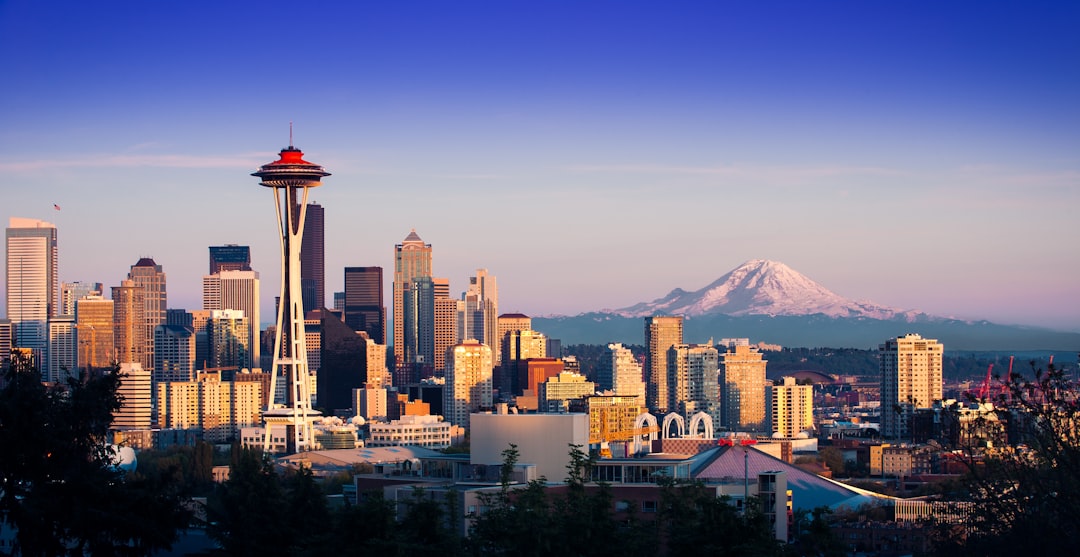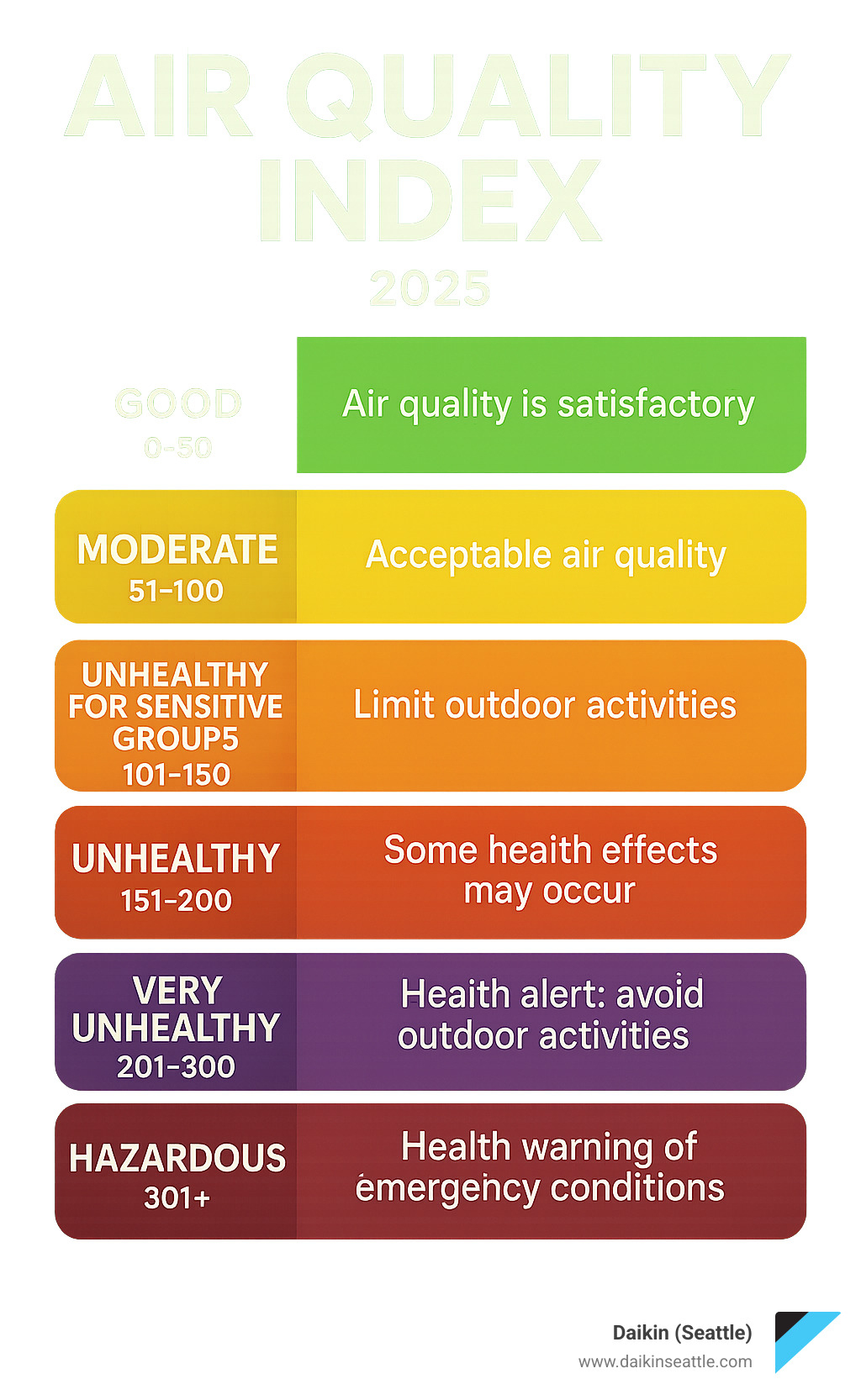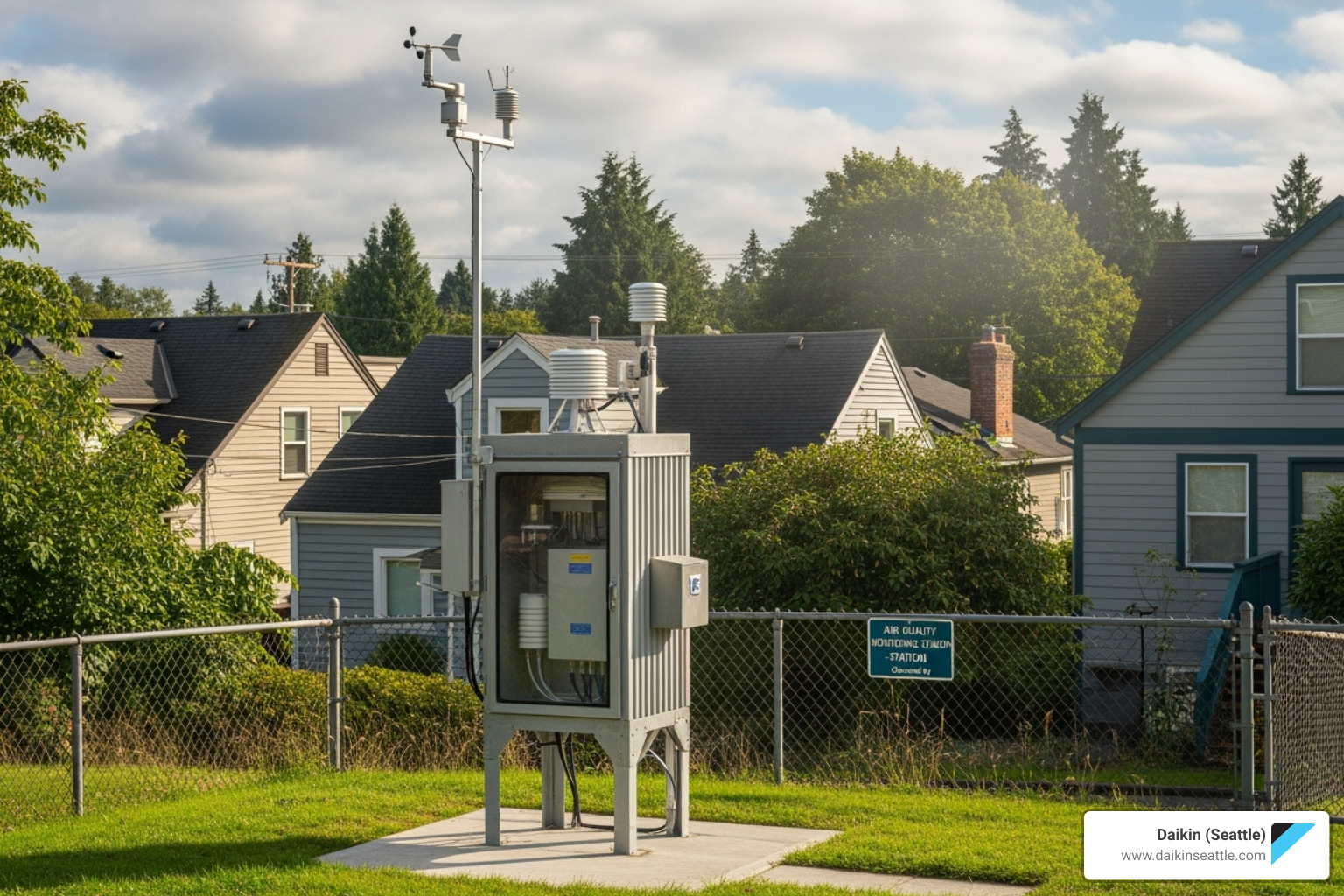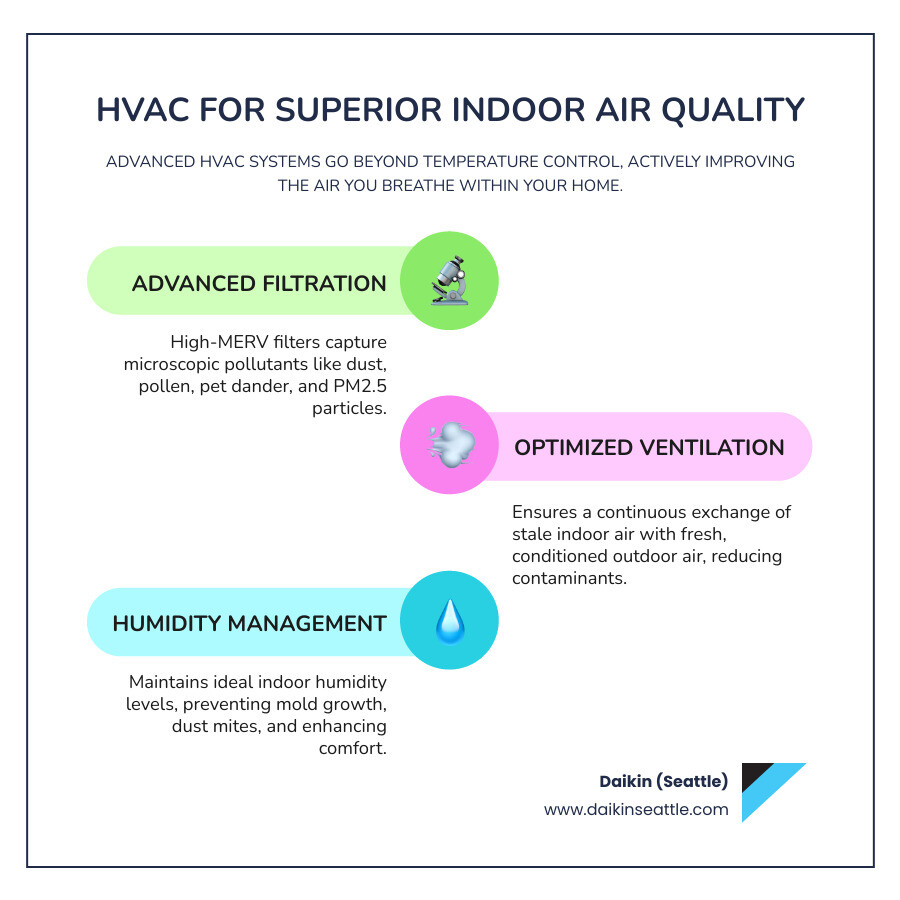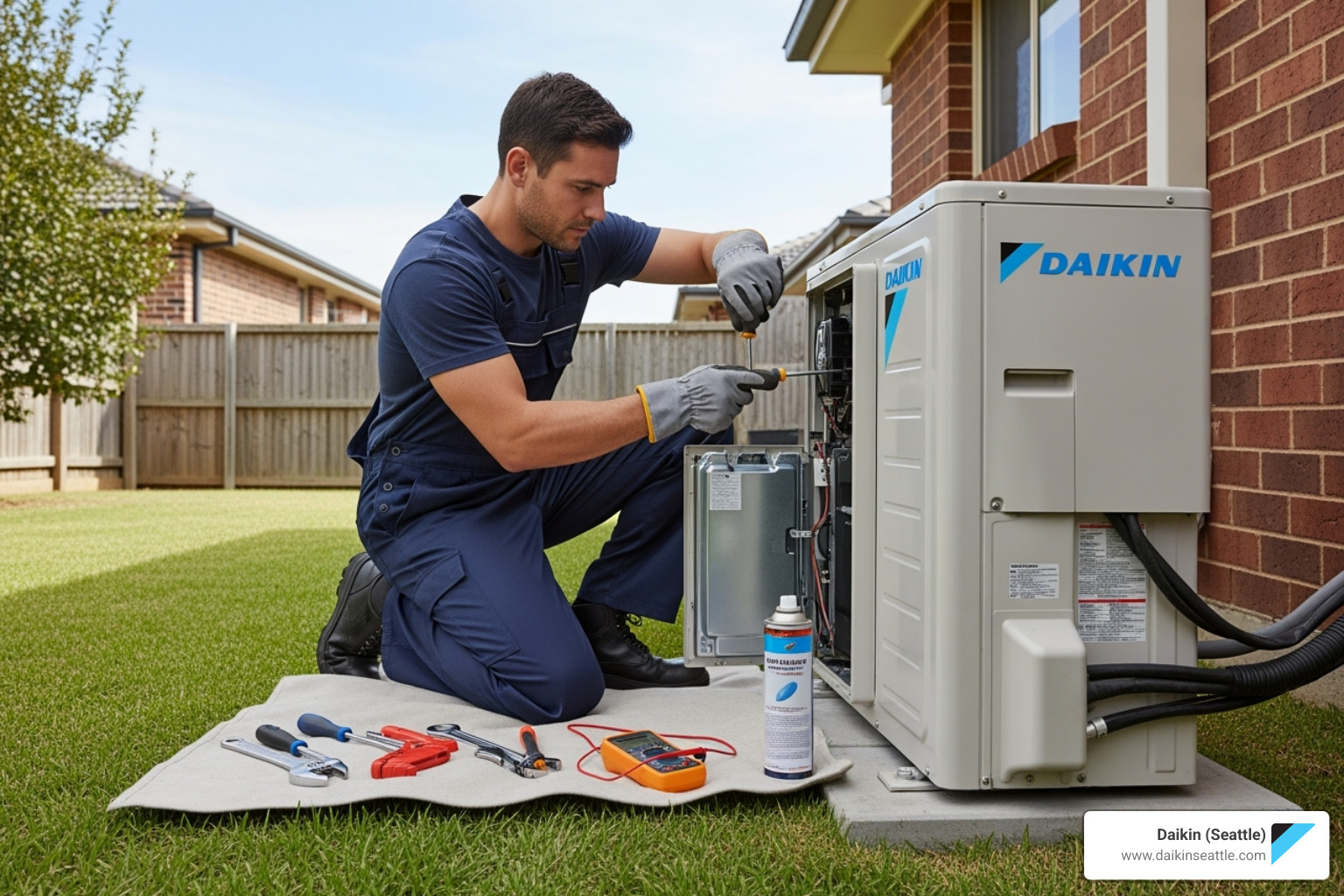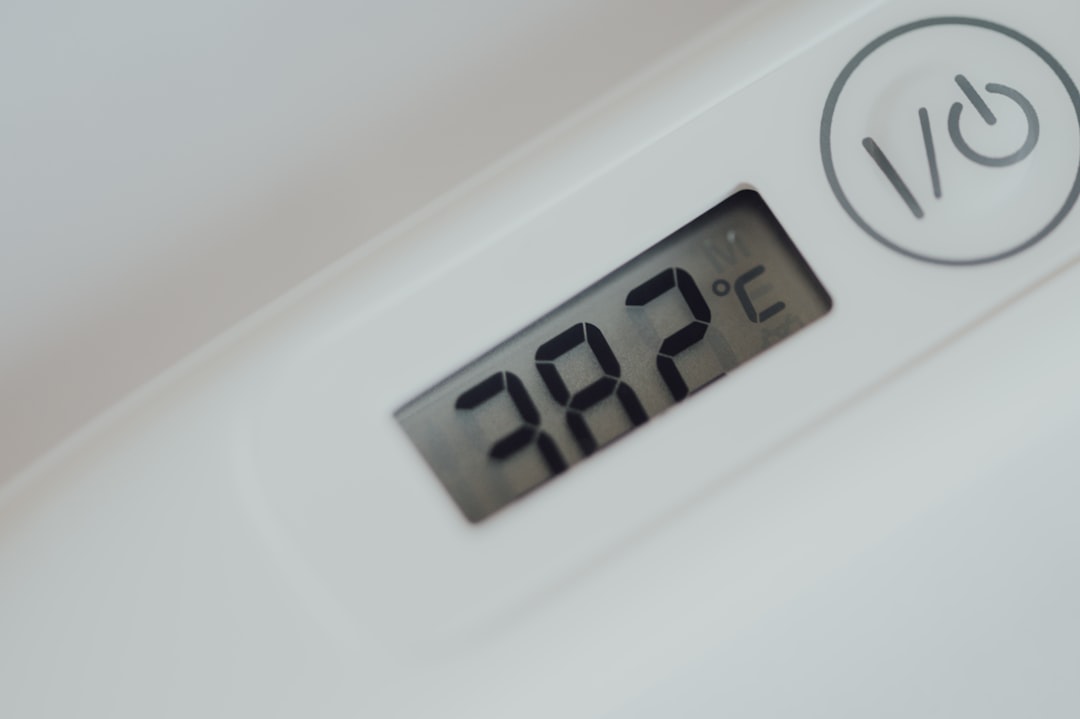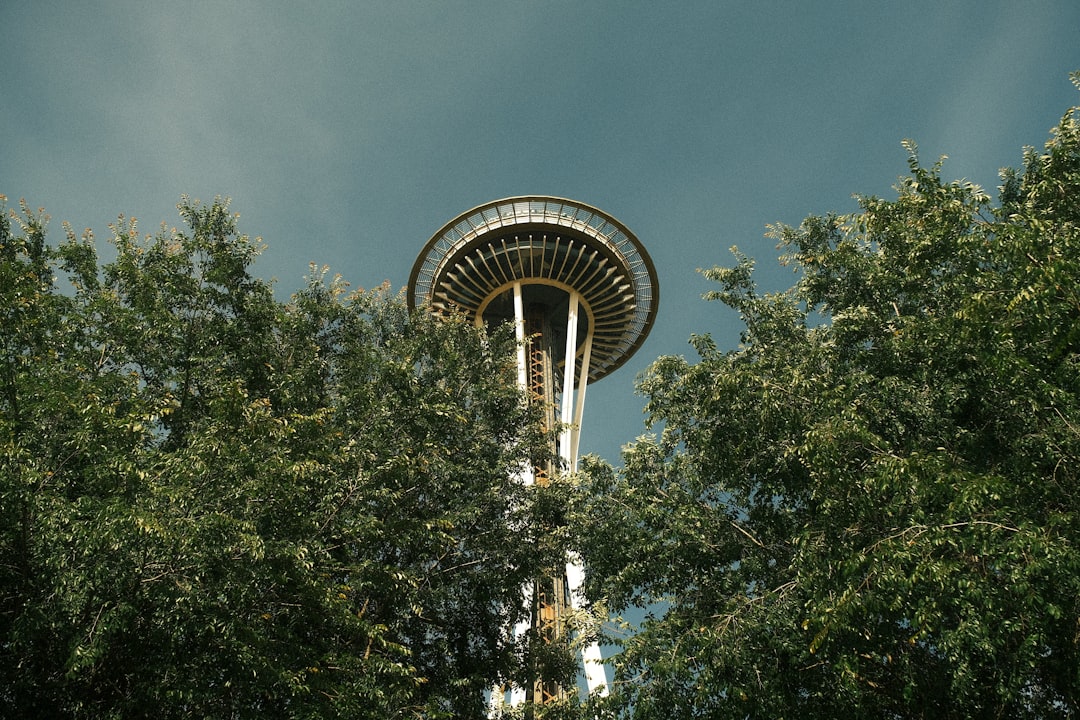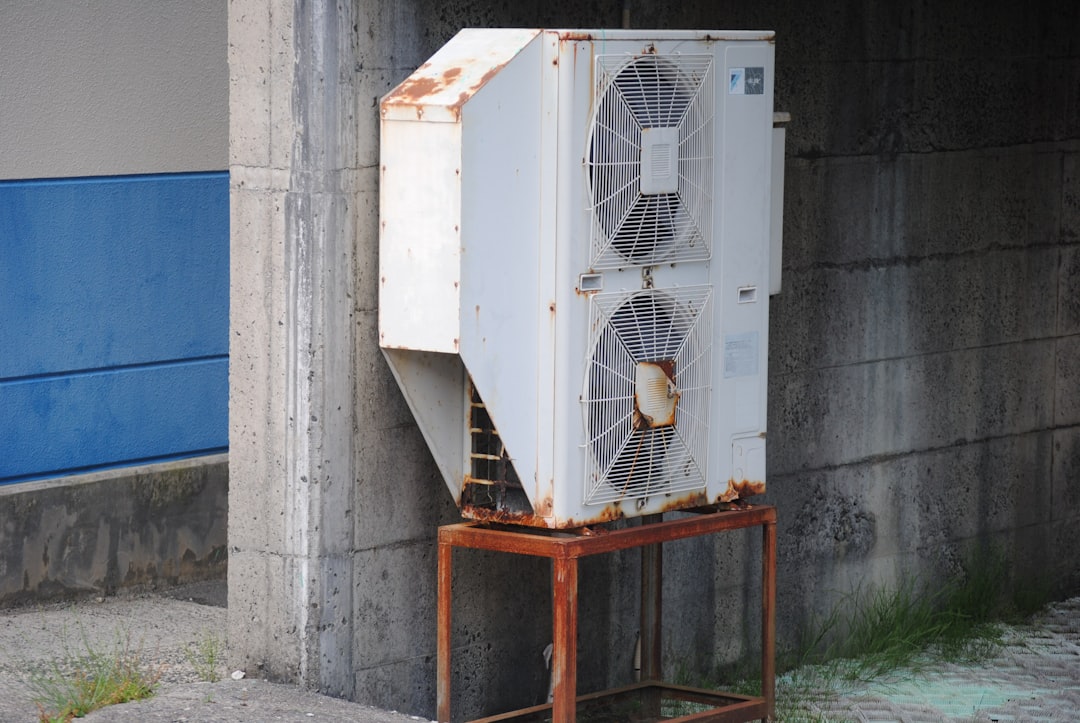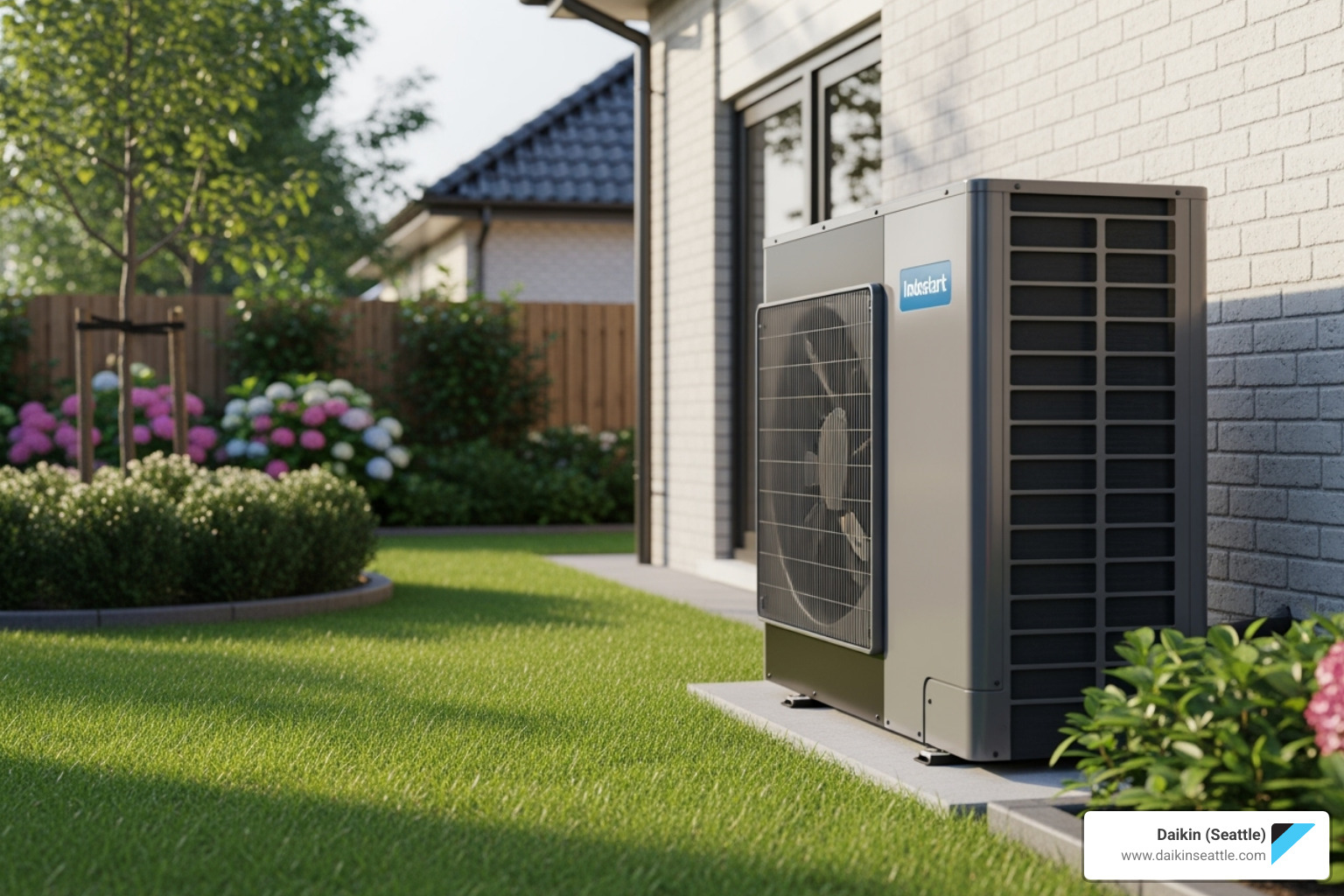Why Seattle Air Quality Monitoring Matters More Than You Think
Seattle air quality monitoring reveals a surprising truth: despite the city’s green reputation, air quality has been declining since 2016, with Seattle failing federal targets for unhealthy pollution days.
Key Seattle Air Quality Monitoring Resources:
- Puget Sound Clean Air Agency – Regional monitoring across King County
- AirNow.gov – Real-time federal data and forecasts
- Washington Air Quality Map – State-level monitoring network
- PurpleAir sensors – Community-based hyper-local monitoring
- Air Quality WA mobile app – Portable access to current conditions
Seattle faces a paradox. The city consistently shows “good” Air Quality Index (AQI) ratings most days of the year. Yet the American Lung Association gave Seattle an “F” grade for both ozone and particle pollution in 2020.
The reality? Seattle averages 14.2 unhealthy pollution days per year – more than double what the EPA recommends. These spikes come from wildfire smoke, vehicle emissions, and industrial sources that can quickly turn a beautiful Pacific Northwest day into a health hazard.
Understanding where to find reliable air quality data isn’t just about planning your morning jog. It’s about protecting your family’s health and making informed decisions about your indoor environment – especially when outdoor air quality fails.
Understanding Seattle’s Air Quality Picture
You might wake up to a perfect-looking Seattle morning with “Good” air quality on your weather app. Yet, our city earned a failing grade from the American Lung Association. How is that possible? The answer lies in what Seattle air quality monitoring reveals about our daily air. Our air quality tells a complex story, shaped by everything from your morning commute to wildfires burning hundreds of miles away.
Primary Pollutants and Their Sources
When we talk about air pollution in Seattle, we’re mainly dealing with two primary pollutants: particulate matter and ground-level ozone.
Particulate Matter (PM2.5) consists of tiny particles so small – just 2.5 micrometers across – that they slip right past your body’s natural defenses and settle deep in your lungs. These microscopic particles come from several sources.
Vehicle emissions top the list, contributing nearly half of Seattle’s air pollution. Every car, truck, and especially those heavy-duty diesel engines chugging along I-5 add to the mix. Neighborhoods like Georgetown and South Park get hit hardest because they’re right in the path of major freight routes.
Wildfire smoke has become our unwelcome seasonal visitor. During late summer and early fall, smoke from fires burning as far away as California or British Columbia can drift into our region. These events can spike PM2.5 levels dramatically, turning a beautiful day hazy and unhealthy.
Wood burning becomes a bigger player during winter months. While there’s something cozy about a crackling fireplace, wood stoves and fireplaces pump out significant PM2.5, especially when temperature inversions trap that smoke close to the ground.
The health impacts of wood smoke are particularly concerning. You can learn more about how wood smoke harms your health from Washington State’s detailed research.
Ground-level ozone is different from the protective ozone layer high above us. This stuff forms when pollutants from cars, power plants, and industrial sources get together in sunlight and create a chemical reaction. As our climate warms, these reactions happen faster and more frequently, extending what experts call “ozone season.”
Historical Trends
Seattle air quality monitoring data shows that since 2016, our air quality has been declining. Both PM2.5 and ozone pollution levels have been creeping upward, breaking a positive trend we’d enjoyed for years.
Why the reversal? Our booming population means more people, more cars, and more economic activity. More people also means more construction, which kicks up dust and particles. Meanwhile, wildfires across the Western United States have become more frequent and severe, sending their smoke our way more often.
The Puget Sound Clean Air Agency has found that PM2.5 levels in winter are about 40 percent higher than in summer, largely thanks to wood burning. When you combine that with temperature inversions – weather patterns that trap pollutants close to the ground – winter air quality can become particularly challenging.
Seattle’s Air Quality vs. National Standards
This brings us to the paradox mentioned earlier. Seattle can show “Good” AQI readings most days and still fail national health standards. This is because a few days with very high pollution levels lead to a failing grade overall.
The American Lung Association gave Seattle an “F” grade for both 24-hour PM2.5 and ozone pollution in 2020. This failing grade isn’t about our average air quality – it’s about those spike days when pollution levels shoot into unhealthy territory.
The EPA recommends no more than 3.2 unhealthy pollution days per year for each pollutant. Seattle averages 14.2 unhealthy pollution days annually – more than four times the recommended limit. That’s 7 days of high ozone and 7.2 days of high PM2.5. While this represents only about 4 percent of the year, these are the days that pose real health risks.
Nationally, Seattle ranks 36th worst for high ozone days out of 229 metropolitan areas, and we tie for 14th worst for particle pollution spikes out of 216 metro areas.
The situation gets even more serious in specific neighborhoods. A 2008 study of the Duwamish Valley found an extra 400 cancer cases per 100,000 people due to hyperlocal pollution sources, mainly from freight truck emissions. This shows how city-wide “good” readings can mask serious environmental health risks in particular communities.
These outdoor air quality challenges naturally make us think about what’s happening inside our homes. If you’re wondering whether outdoor pollution is affecting your indoor air, it’s worth recognizing the poor indoor air quality signs that might indicate problems.
Understanding Seattle’s air quality picture helps us make better decisions about protecting our health – both when we’re outside enjoying our beautiful city and when we’re inside seeking clean, comfortable air.
Official Seattle Air Quality Monitoring and Data Sources
When you step outside in Seattle and wonder if that haze is just morning mist or something more concerning, you’re not alone. Fortunately, we have a dedicated team of organizations working around the clock to monitor what we’re all breathing. Seattle air quality monitoring is truly a team effort, bringing together federal, state, and local agencies who each play a vital role in keeping us informed.
Key Agencies
The Puget Sound Clean Air Agency (PSCAA) is our local air quality champion. Think of them as the neighborhood watch for our air – they know our region intimately and focus specifically on what matters most here in the Pacific Northwest. PSCAA monitors air pollution across King, Kitsap, Pierce, and Snohomish Counties, with a special focus on fine particle pollution because of its serious health impacts. Beyond their main monitoring stations, they’ve also deployed smaller sensors throughout the region, giving us a much more detailed picture of air quality variations from neighborhood to neighborhood.
At the state level, the Washington State Department of Ecology operates a comprehensive network of monitoring stations across our entire state. They’re the ones measuring everything from carbon monoxide and ozone to particle pollution and sulfur dioxide. Their data helps determine whether we’re meeting federal air quality standards and plays a crucial role in decisions like burn bans during stagnant air periods.
The Environmental Protection Agency (EPA) sets the national standards that everyone follows and brings together data from state and local agencies nationwide. Their AirNow platform serves as a central hub where you can quickly check air quality conditions and compare Seattle to other cities across the country.
Impact of Weather Patterns
Here’s something that might surprise you: the weather forecast can be just as important as the pollution sources themselves when it comes to air quality. Strong winds are like nature’s air purifier, sweeping pollutants away and giving us those crisp, clear days we love. But when the air becomes stagnant, pollutants just sit there, building up like unwelcome house guests who won’t leave.
Temperature inversions are particularly troublesome during our winter months. Picture a lid being placed over the city – that’s essentially what happens when warm air sits on top of cooler air near the ground. Pollutants get trapped and can’t rise to disperse, which is why wood smoke can become so concentrated during those cold, still winter nights.
Rain, on the other hand, acts like a natural car wash for our atmosphere, literally washing pollutants out of the air and temporarily improving conditions.
Wildfire Season Effects
If you’ve lived in Seattle for the past few years, you’ve definitely experienced those eerie orange-sky days when wildfire smoke rolls in. These fires might be burning hundreds of miles away, but their impact on our air quality can be dramatic and immediate. During late summer and early fall, PM2.5 levels can jump from “good” to “hazardous” faster than you can say “wildfire season.” This isn’t just about poor visibility – it’s a genuine health concern that makes real-time Seattle air quality monitoring absolutely essential.
How to Access Real-Time Seattle Air Quality Monitoring Data
The good news is that accessing current air quality information has never been easier. You don’t need to be a scientist to stay informed about what you’re breathing.
AirNow.gov serves as your go-to federal resource for air quality data. It provides current conditions and forecasts for cities nationwide, including Seattle, making it perfect for a quick daily check. During wildfire season, their Fire & Smoke Map becomes invaluable – it shows active fires and smoke plumes so you can understand exactly where that haze is coming from and where it’s headed.
For more localized information, the PSCAA Sensor Map gives you real-time fine particle levels from their monitoring network throughout our four-county region. This is particularly useful because air quality can vary significantly from neighborhood to neighborhood.
The Washington Air Quality Map from the Department of Ecology offers the broadest view, covering our entire state with data from various monitoring stations and different types of pollutants. You can access this comprehensive resource at Washington Air Quality Map.
For ultimate convenience, the Air Quality WA mobile app puts all this information right in your pocket. Available for both Apple and Android devices, it provides current conditions and forecasts wherever you are, making it easy to plan your outdoor activities or decide whether to keep the windows closed.
Understanding what’s happening with outdoor air quality naturally leads to questions about the air inside our homes. After all, we spend most of our time indoors. If you’re curious about assessing your indoor air quality, our guide on Measuring Indoor Air Quality can help you take control of your home’s air environment.
Community Efforts: Grassroots Monitoring and City Initiatives
While official agencies provide the backbone of Seattle air quality monitoring, something remarkable is happening at the grassroots level. Residents are taking air quality into their own hands, and our city leaders are stepping up with ambitious policies that could transform how we breathe.
It’s a powerful combination: citizen scientists filling in data gaps while policymakers work on long-term solutions. Together, they’re creating a more complete picture of our air quality challenges and actively working to solve them.
Citizen Science Role and Hyper-Local Data Benefits
Here’s the thing about official air quality monitors: they’re incredibly accurate, but there just aren’t enough of them. Imagine trying to understand Seattle’s weather with only three thermometers spread across the entire city. That’s essentially what we’re dealing with when it comes to air quality.
This is where citizen science becomes a game-changer. Regular folks are installing small, affordable sensors on their homes, creating a dense network of monitors that can tell us what’s happening block by block.
The beauty of hyper-local data is that it reveals the truth about air pollution: it’s not evenly distributed. Your street might have perfectly clean air while the next block over, near a busy truck route, could be dealing with much higher pollution levels. Traditional monitoring might miss these pockets entirely.
During wildfire season, this neighborhood-level detail becomes crucial. Community sensors can track smoke plumes in real-time, showing exactly which areas are getting hit first and hardest. It’s the difference between knowing “Seattle has smoky air” and knowing “my specific neighborhood is still clear, but I should close the windows because smoke is moving in from the south.”
City-Wide Policies
Seattle isn’t just monitoring the problem – we’re actively fighting it. Our city and county have launched some pretty ambitious initiatives that could dramatically improve our air quality over the next decade.
The electric vehicle push is probably the most visible effort. Seattle aims for 30 percent of all privately owned vehicles to be electric by 2030. That might sound modest, but consider this: transportation accounts for nearly half of our air pollution. Every gas car replaced with an electric one is a direct win for cleaner air.
King County’s electric bus fleet plan is even more ambitious. By 2040, all 1,400 county buses will be electric. If you’ve ever been stuck behind a diesel bus belching exhaust, you’ll appreciate what a massive improvement this will be. These aren’t just environmental feel-good measures – they’re practical steps that will make our daily commutes healthier.
The city has also been tackling clean diesel programs since 2001, focusing on those heavy-duty trucks that contribute disproportionately to pollution in neighborhoods like Georgetown and South Park. While we can’t eliminate freight traffic overnight, we can make it cleaner.
Beyond transportation, Seattle is investing in renewable energy purchasing and working to reduce solid waste emissions by capturing landfill gases and converting them to energy instead of letting them escape into our air.
The Role of Community-Based Seattle Air Quality Monitoring
The star of community-based Seattle air quality monitoring has to be PurpleAir sensors. These purple boxes are popping up on homes across the city, and for good reason. They’re affordable, easy to install, and provide real-time data that anyone can access.
What makes PurpleAir special is how accessible it makes air quality information. You don’t need a PhD in environmental science to understand the readings. The sensors measure particulate matter, temperature, and humidity, then display everything on an easy-to-read map. You can Explore The Map right now and see exactly what the air quality is like in different Seattle neighborhoods.
These community sensors complement official networks perfectly. While government monitors provide the gold standard for accuracy and regulatory compliance, PurpleAir sensors create a safety net of information. They can quickly identify pollution hotspots, track wildfire smoke as it moves through the region, and help residents make immediate decisions about their health.
The data accessibility aspect can’t be overstated. When you can see that the air quality on your street is different from the reading five miles away at an official monitor, it empowers you to make better choices. Maybe you decide to keep the windows closed, skip that outdoor workout, or turn on your air purifier.
This grassroots monitoring movement is helping us understand neighborhood-level differences that were previously invisible. It’s citizen science at its best – regular people contributing to our collective understanding of the environment we all share.
And while we’re getting better at monitoring outdoor air, understanding what’s happening inside our homes is equally important. If you’re curious about taking control of your indoor environment, learning How to Measure Indoor Air Quality is a great next step.
Frequently Asked Questions about Seattle’s Air Quality
Living in Seattle, we’ve all had those moments when the air just doesn’t feel right. Maybe it’s a hazy summer day when wildfire smoke rolls in, or a crisp winter morning when wood smoke seems to hang in the air. These experiences naturally raise questions about what we’re breathing and how it affects our health.
What are the biggest health risks from Seattle’s air pollution?
The truth is, air pollution affects all of us differently, but understanding the risks helps us make better decisions for our families. Seattle air quality monitoring data shows that even on days when the air looks clear, pollutants can still impact our health.
Short-term effects are often the first signs that something’s not right with the air around us. You might notice respiratory irritation like coughing, shortness of breath, or that tight feeling in your chest. For anyone dealing with asthma, poor air quality days can quickly trigger attacks. Many people also experience eye, nose, and throat irritation, along with headaches and unusual fatigue.
The long-term risks are more concerning, especially with chronic exposure to fine particulate matter (PM2.5). Over time, this exposure increases your risk of heart disease and stroke, can contribute to lung cancer development, and worsens chronic respiratory diseases like bronchitis and emphysema. For children, prolonged exposure can actually reduce lung function as they grow.
Sensitive groups face the greatest challenges. Children are particularly vulnerable because their lungs are still developing, and they naturally breathe more air per pound of body weight than adults. Elderly residents often have pre-existing heart or lung conditions that make them more susceptible. If you or a family member has asthma, COPD, heart disease, or diabetes, you’re at higher risk during poor air quality days.
The Duwamish Valley situation we mentioned earlier really drives this home – that 2008 study linking truck emissions to an extra 400 cancer cases per 100,000 people shows how localized pollution can create serious health burdens. The World Health Organization reminds us that no level of PM2.5 exposure has been proven completely safe.
When is air quality typically worst in Seattle?
Understanding Seattle’s pollution patterns helps you plan ahead and protect your family when air quality is most likely to deteriorate.
Late summer and early fall have become our most challenging seasons. This is when wildfire smoke from across the Western United States can blanket our region, sometimes with little warning. August has been particularly problematic in recent years – it was the most polluted month in both 2017 and 2018 due to wildfire impacts. What’s frustrating is that these fires can be hundreds or even thousands of miles away, yet still dramatically spike our PM2.5 levels.
Winter months bring their own challenges, primarily from wood smoke and temperature inversions. When temperatures drop and the air becomes still, wood-burning stoves and fireplaces create a different kind of pollution problem. Temperature inversions act like a lid, trapping smoke near the ground where we breathe it. This is why you’ll see burn bans issued during cold, still periods.
Stagnant air events can happen any time of year and create problems regardless of the season. When we have prolonged periods of calm winds and stable atmospheric conditions, all types of pollutants build up instead of dispersing naturally.
How can I protect my health on poor air quality days?
The good news is that once you know what to watch for, there are practical steps you can take to protect yourself and your family.
Checking real-time data should become part of your daily routine, especially during wildfire season or those cold winter spells. Make use of those Seattle air quality monitoring resources we discussed – AirNow, the PSCAA map, and the Air Quality WA app are all excellent tools that update throughout the day.
Limiting strenuous outdoor activities is crucial when AQI levels reach unhealthy ranges, particularly if anyone in your family is in a sensitive group. If you absolutely must be outside during poor air quality periods, consider wearing a high-quality N95 or KN95 mask.
Keeping windows closed might seem obvious, but it’s one of the most effective ways to prevent outdoor pollutants from entering your home. This is especially important during wildfire events or when wood smoke is heavy in your neighborhood.
Your home’s HVAC system can be your best ally in maintaining clean indoor air. Make sure you’re using high-efficiency filters – we recommend MERV 13 or higher to capture those fine particles. The key is changing these filters regularly, as dirty filters can’t do their job effectively.
Indoor air purifiers provide an extra layer of protection, particularly in bedrooms or main living areas. Look for units with HEPA filters that can significantly reduce indoor particulate matter, giving you peace of mind even when outdoor conditions are poor.
Protecting your health starts with understanding what’s happening outside, but it’s equally important to ensure your indoor environment is as clean and healthy as possible. For comprehensive strategies to create the healthiest possible indoor environment for your family, explore our Indoor Air Quality Solutions Seattle.
Conclusion: From Outdoor Awareness to Indoor Action
We’ve journeyed through the complex reality of Seattle air quality monitoring, finding that our beloved green city faces real challenges. From the American Lung Association’s “F” grade to those 14.2 unhealthy pollution days each year, the data tells a story that goes beyond our city’s eco-friendly reputation.
The good news? We’re not powerless in this situation.
Through agencies like the Puget Sound Clean Air Agency and grassroots efforts with PurpleAir sensors, we have access to real-time data that empowers us to make smart decisions. Whether it’s checking AirNow.gov before a morning run or using the Air Quality WA app to plan weekend activities, Seattle air quality monitoring puts valuable information right at our fingertips.
But here’s the thing – while we can’t control wildfire smoke drifting in from hundreds of miles away or eliminate traffic on I-5, we have tremendous control over the air inside our homes. And considering we spend about 90% of our time indoors, that’s where we can make the biggest difference for our health.
This is where the story gets exciting. Your home doesn’t have to be at the mercy of outdoor air quality conditions. With advanced HVAC solutions, you can create a true sanctuary where clean, comfortable air is the norm, not the exception.
At Daikin, we understand that protecting your family’s health goes beyond just heating and cooling. Our systems are designed with superior filtration and climate management that actively improve your indoor air quality. Our energy-efficient heat pumps and innovative inverter technology work together to filter out the pollutants that outdoor monitoring tells us are present.
What makes our approach special is our Pacific Northwest Daikin Experience Center right here in Seattle. You can actually see, touch, and experience how these systems work before making a decision. It’s not just about buying equipment – it’s about understanding how to create the healthiest possible environment for your family.
The reality is that Seattle’s growing population and booming economy don’t have to mean compromising on the air you breathe at home. Your indoor environment can remain clean and healthy regardless of whether the outdoor AQI shows green or red.
Ready to take control of your indoor air quality? Ensure your home is a safe haven with an Indoor Air Quality Monitor in Seattle and find how monitoring and advanced HVAC solutions work together to protect what matters most – your family’s health and comfort.

